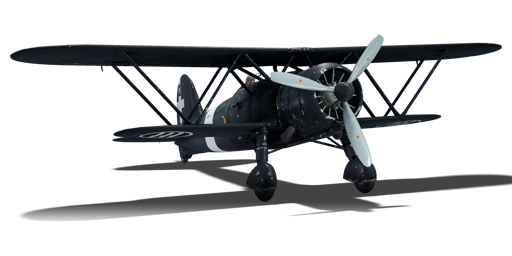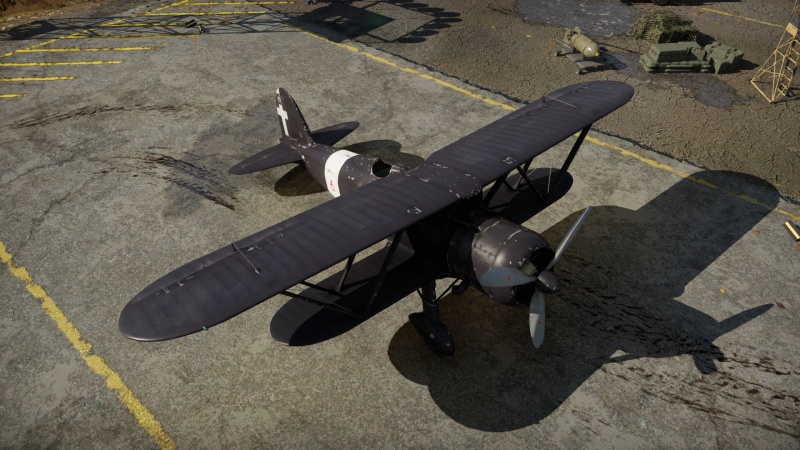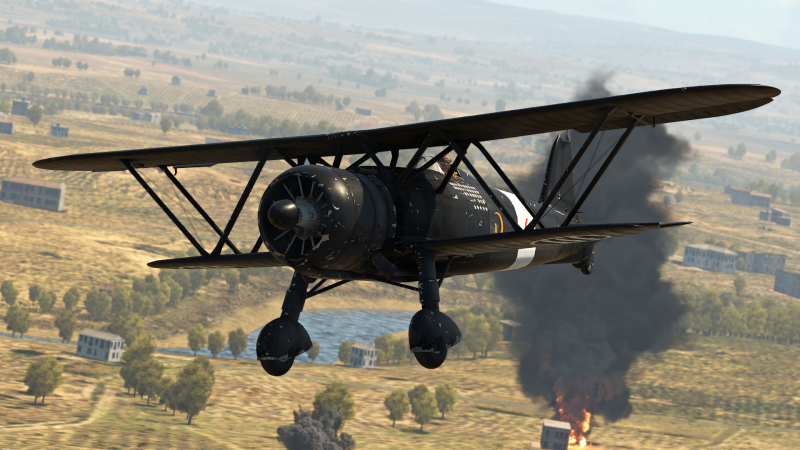Marcolin's C.R.42 CN
| This page is about the premium Italian fighter Marcolin's C.R.42 CN. For other versions, see C.R.42 (Family). |
Contents
Description
The CR.42 was an attempt by FIAT to modernize the CR.32 that saw great success in the Spanish Civil War. The CR.42 would also be an excellent biplane and was considered the best biplane of World War II by many experts and analists. Even though it was outdated, in early World War II it saw some success as an escort fighter, night fighter and even interceptor, it was even capable of dogfighting with some of the early variants of the Hurricane and Spitfire. When the war progressed the CR.42 was relegated to night bombing, light ground attacker or patrol. One of the most influential pilots of the night fighter variant of the CR.42 (The CR.42 CN) was the Italian pilot Luciano Marcolin, the commanding officer of the 377a Squadriglia Autonoma.
The Marcolin's C.R.42 CN was originally introduced in the German tech tree as a premium vehicle and is still available to those who unlocked it, however it was moved to the Italian tech tree as a gift vehicle in Update 1.69 "Regia Aeronautica". The Marcolin's C.R.42 CN possesses exceptional manoeuvrability, speed, and durability, especially for a biplane. Its armament is quite good as well, due to the Breda-SAFAT .50 calibre MGs. The C.R.42 usually fights early P-36s and LaGG-3s. As such, the majority of aircraft the C.R.42 will engage are faster, and more heavily armed. Your best chances are climbing medium altitude, and lure fighters into turning combat. The majority of pilots underestimate biplanes, allowing you to score critical damage before they realize it's too late to retreat. By that time, the damage is usually severe enough that they cannot accelerate away from you quickly enough to escape further damage. Against other biplanes the CR.42 works best in extended dogfights, since you can retain energy better than other biplanes like the I-15 and Gladiator MK.II.
General info
Flight performance
| Characteristics | Max Speed (km/h at 5,200 m) |
Max altitude (metres) |
Turn time (seconds) |
Rate of climb (metres/second) |
Take-off run (metres) | |||
|---|---|---|---|---|---|---|---|---|
| AB | RB | AB | RB | AB | RB | |||
| Stock | 413 | 402 | 8500 | 20.0 | 20.6 | 14.2 | 14.2 | 294 |
| Upgraded | 448 | 429 | 18.5 | 19.2 | 21.1 | 17.2 | ||
As one of the last generation of biplane fighters, the CR.42 incorporates many advantages , but also disadvantages of said built. Notably a low stall speed, predicating it for turn fights. Climb speed is good to great, but cannot compare to many later fighters (Rank II). Another advantage gained is the relatively high break speeds of ~570 km/h IAS and the late lock up speed of 450 IAS for the elevator. The top speed is good for Rank I, but only reached after a short dive and quickly dwindles with damage received.
Details
| Features | ||||
|---|---|---|---|---|
| Combat flaps | Take-off flaps | Landing flaps | Air brakes | Arrestor gear |
| X | X | X | X | X |
| Limits | ||||||
|---|---|---|---|---|---|---|
| Wings (km/h) | Gear (km/h) | Flaps (km/h) | Max Static G | |||
| Combat | Take-off | Landing | + | - | ||
| 578 | 580 | N/A | N/A | N/A | ~16 | ~7 |
| Optimal velocities (km/h) | |||
|---|---|---|---|
| Ailerons | Rudder | Elevators | Radiator |
| < 280 | < 240 | < 450 | > 250 |
| Compressor (RB/SB) | ||
|---|---|---|
| Setting 1 | ||
| Optimal altitude | 100% Engine power | WEP Engine power |
| 4,300 m | 828 hp | 973 hp |
Survivability and armour
Biplanes by design have a lot of surface and consequently have plenty of aircraft to be shot at. This makes them feel more vulnerable than they really are, although again: They are fairly big, hard to miss targets, so the feeling is justified. Even more so as the fabric skin is easily damaged by small arms fire. The change to a aluminium monocoque fuselage design was linked with an increase in armament size for a reason. However, here lies a great advantage: Many explosive triggers and fuses have their detonation sensitivities set to metal skins, not fabric ones, so they may just whizzle through your craft, leaving only two 20 mm sized holes.
The CR.42 in itself features no armour. Only the air cooled rotary engines is rather durable due to lacking any water-cooling and by design.
Modifications and economy
Armaments
Offensive armament
Marcolin's C.R.42 CN is armed with:
- 2 x 12.7 mm Breda-SAFAT machine guns, nose-mounted (400 rpg = 800 total)
The two machine guns are both mounted on the upper fuselage just in front of the pilot and fire through the propeller arc. Each is armed with the same amount of ammunition, which means that all guns will fire together until empty.
The center lined armament is always a great advantage. However compared to other nations' fighters with their fast firing 7.7 mm machine guns, the Breda's slower rate of fire offsets the gained advantage in calibre size and explosive ammunition (IAI).
Usage in battles
In AB, the C.R.42 is nothing more than a point-and-shoot arcade-style plane. There is little skill involved at these early rank matches. Therefore turning is the most appropriate tactic. However, due to the high climb rate, Boom & Zoom can be effective, as most monoplanes cannot nearly climb as fast.
As in real-life the Falco faces off advanced mono-wing designs. While a grim view at first the C.R.42 is the pinnacle of biplane evolution, only rivalled by the up-gunned Chaika series. Common opponents are faster and have superior armament. However, the C.R.42 has got traits to counter. It is immensely agile, and can easily out-manoeuvre any monoplane in Rank I. Turning is thus an appropriate tactic for the C.R.42. Due to it being a biplane, the Falco can also be used to effectively rope-a-dope enemy aircraft. Stall fighting is one of the strongest play styles, albeit the slowest and hardest to master.
Even Boom & Zoom is feasible, as altitude can be gained quickly; however, the lack of cannon armament forces the pilot to use significant trigger control as well as aiming when diving and attacking opponents at a lower level. If BnZing, watch your speed in a dive. The C.R.42 does have a limit of around 440 - 480 km/h (274 - 300 mph) before instability sets in.
The Breda SAFAT .50 calibre MGs are actually very effective for their BR. Tracers are by far the best belt for these main armament, due to the presence of entirely API-T rounds, which easily set fire to enemy planes and provide good penetration and damage capability. Due to the MGs being placed in the centre cowl, they provide heavy damage when fire is focused on your opponent's wings or engines. Unfortunately, MGs in general are ridiculously weak against bombers.
Visibility is normal for a biplane. Rearward vistas are non-existent while forward vision is hampered by the second strut/wing. The open cockpit does provide decent visibility in general, though.
Manual Engine Control
| MEC elements | ||||||
|---|---|---|---|---|---|---|
| Mixer | Pitch | Radiator | Supercharger | Turbocharger | ||
| Oil | Water | Type | ||||
| Controllable | Controllable Not auto controlled |
Not controllable Not auto controlled |
Controllable Not auto controlled |
Separate | Not controllable 1 gear |
Not controllable |
Pros and cons
Pros:
- High speed for a biplane
- Good ammunition count
- Manoeuvrability is sufficient to out turn nearly all non biplane opponents
- Well armed for a biplane
- Ammo belts use heavy amounts of incendiary ammo
Cons:
- Poor energy retention
- Lightly armed compared to most of the opposition it is faced with
- No options for striking heavy targets
- Turn rate is worse than of most biplanes
- Poor armour protection
History
The C.R.42 was Fiat's attempt at modernizing their C.R.32 design, which was deployed during the Spanish Civil War with great success. The new fighter would be of all metal construction, with Fiat's new, home-grown A.74 supercharged radial engine. The result, was a fast, accurate, and manoeuvrable platform, that, while outdated at the onset of World War Two, would be almost the pinnacle of biplane design.
Early in the war, C.R.42s were used with some success as escorts, night fighters, and even interceptors. Against the early Hurricanes and Spitfires, Italian and German pilots both were delighted to find that the manoeuvrability of the Falco put it, at the least, on par in a dogfight. However as the war dragged on, and enemy aircraft became faster, the C.R.42 was relegated to night harassment, light ground attack, and sparingly used as night fighters.
The C.R.42 is also credited with the world's last aerial combat biplane kill. A group of C.R.42s based in Croatia under the command of Nachtschlachtgruppe 7 were directed to Grabovica Airfield for a strafing mission. However, the flight was redirected at the last moment to a harassment mission Northwest of Sisak, where they were intercepted by P-38s of the 14th Fighter Group. Three Fiats were lost for two P-38s, one of which was claimed by an unknown German pilot.
Media
- Skins
- Videos
See also
- Aircraft of comparable role, configuration and era
External links
| Fiat Aviation (Fiat Aviazione) | |
|---|---|
| Fighters | CR.32 · CR.32 bis · CR.32 quater |
| CR.42 · Marcolin's C.R.42 CN · ▀Marcolin's C.R.42 CN | |
| G.50 serie 2 · G.50 AS serie 7 | |
| G.55 sottoserie 0 · G.55 serie 1 · G.55S | |
| G.56 | |
| Jet fighters | G.91 pre-serie · G.91 R/1 · G.91 Y · G.91 YS |
| ▄F-86K* | |
| ▄F-104G* · F-104S* · F-104S.ASA* · ▄F-104S TAF* | |
| Strike aircraft | F.C.20 Bis |
| Bombers | B.R.20DR · B.R.20M M1 |
| Export/Captured | J11 · ▀CR.42 |
| ▀G.50 serie 2 · ▀G.50 AS serie 7 | |
| ◄G.91 R/3 · ◄G.91 R/4 · G.91 R/4 | |
| *Licensed | |
| See also | North American Aviation · Lockheed Martin |
| Italy fighters | |
|---|---|
| Fiat | CR.32 · CR.32 bis · CR.32 quater · CR.42 · Marcolin's C.R.42 CN |
| G.50 serie 2 · G.50 AS serie 7 | |
| G.55 sottoserie 0 · G.55 serie 1 · G.55S · G.56 | |
| Reggiane | Re.2000 G.A. · Re.2000 serie 1 |
| Re.2001 serie 1 · Re.2001 gruppo 22 · Re.2001 CB · Re.2001 CN | |
| Re.2002 Early | |
| Re.2005 serie 0 | |
| Macchi | C. 200 serie 3 · C. 200 serie 7 |
| C. 202 · C. 202D · C. 202EC | |
| C. 205 serie 1 · C. 205 serie 3 · C. 205N2 | |
| IMAM | Ro.44 |
| Foreign: | |
| Germany | ▄Bf 109 G-14/AS |
| USA | ▄P-47D-30 |
| Britain | ▄Spitfire Mk Vb/trop |
| Romania | He 112 B-1/U2 · IAR-81C |
| Hungary | ◐Bf 109 F-4 · ◐Bf 109 G-2 · ◔Yak-9P |
| Italy premium aircraft | |
|---|---|
| Fighters | CR.32 bis · Marcolin's C.R.42 CN · He 112 B-1/U2 · Re.2001 gruppo 22 |
| C. 202D · IAR-81C · ▄Spitfire Mk Vb/trop · ◐Bf 109 F-4 · ◐Bf 109 G-2 · G.55S | |
| Jet fighters | Ariete · G.91 R/4 · ▄F-104S TAF |
| Strike aircraft | ◐Bf 110 G-4 · Hs 129 B-2 (Romania) · Ro.57 Quadriarma |
| AMX A-1A | |






